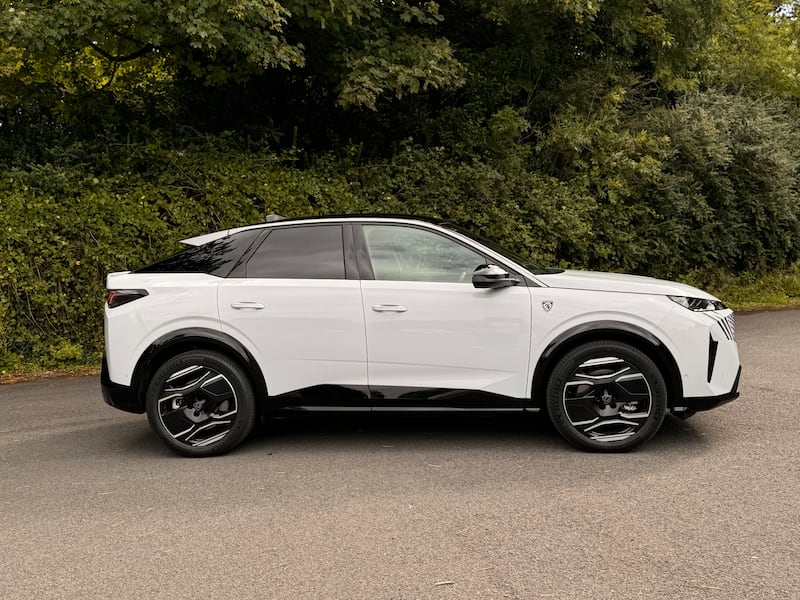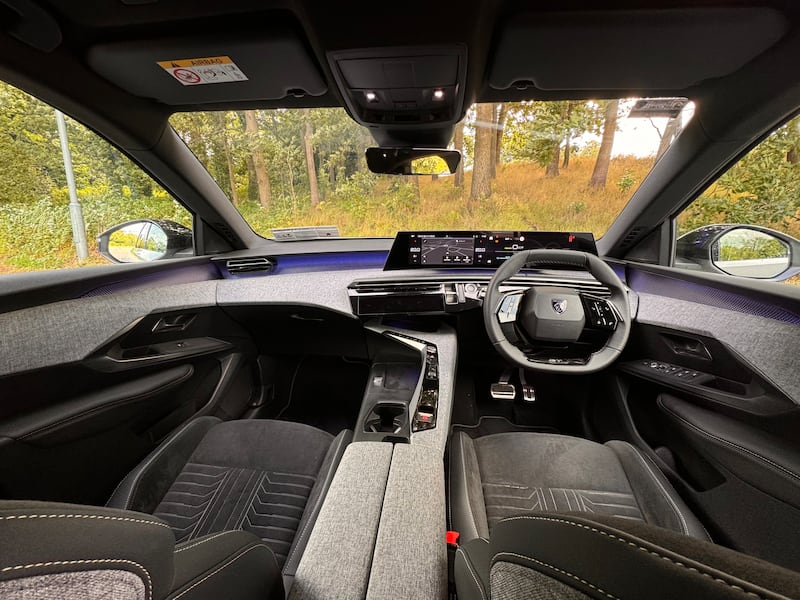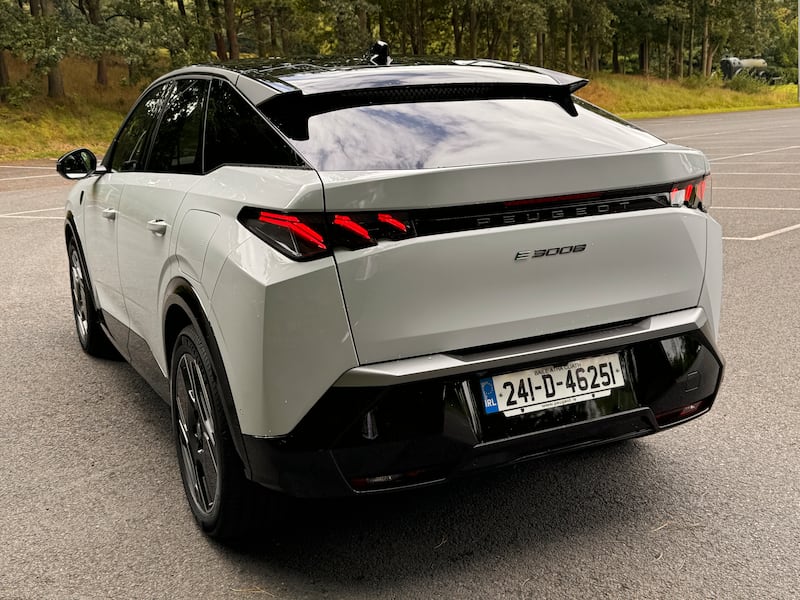Sometimes, a car comes right out of left field and surprises you; a car you just weren’t expecting a big surprise from.
Hitherto, the Peugeot 3008 has not been a hugely surprising car. The first generation was dumpy on the outside but good to drive underneath. The chiselled second generation was handsomer by far, and better again to drive, but surprising? No, it was Peugeot’s answer to the Qashqai, and so it hit predictable, steady, marks.
This time around, for the third-generation 3008, Peugeot has done something... surprising. I might say even daring.
No, I don’t mean the mere fact that the 3008, or to be more specific this E-3008, has gone fully electric. Peugeot has been gearing up for electric power for some time, and while the guys at Gowan Auto – Peugeot’s Irish importer and distributor – admit that this battery-powered 3008 will be vastly outsold for now by the simpler 1.2-litre 136hp petrol hybrid, it’s not actually a surprise that there is a fully-electric version.

Equally unsurprising, in many ways, are the electric underpinnings of the E-3008. Stellantis Group – the sprawling car-making conglomerate of which Peugeot is but a one-14th (or 15th depending on how you count it) component – has long since been trailing its SLTA electric car platforms, designed to take its multiplicity of brands into the 2030s on battery power.
This E-3008 uses the STLA-Medium platform, and it for now comes with a 73kWh (net usable) battery pack and a single 210hp motor driving the front wheels. So far, so electrically predictable, and Peugeot’s claimed 512-527km range puts it right in the midst of competition such as the Volkswagen ID. 4, the Hyundai Ioniq 5, the Nissan Ariya, and so on.
Hang on though – this is where the surprises start to kick in. Surprise one is the styling, I kind of hadn’t clocked it in the various photos and videos I’d seen of the E-3008 before I’d driven it, but this is a truly daringly styled car.
The front is almost all grille, with tiny slits left out for LED headlights and the “lion’s claw” three-bar LED running light. It’s way more dramatic in person than it looks on paper or screen, and while there’s a slight sense of it having been smacked in the face with a shovel at some point, it’s certainly arresting. The blocky, almost Lego-like rear end inescapably reminds me of the Transformers toys that filled my bedroom as a child.
From the side, it’s clear that this is an SUV-coupe, although Peugeot, almost alone among carmakers, doesn’t charge extra for it. As I always say, an SUV-coupe is not a coupe at all, but the fast-angled rear roof and hatch of this E-3008 unquestionably puts it among the VW ID. 5, Skoda Enyaq Coupe, and the incoming new Ford Capri as a direct rival.
However, it’s much more affordable than those. In fact, at €43,965, not only does the E-3008 undercut the price of the most basic ID. 5 by about €2,000, it’s also actually cheaper to buy than the 3008 hybrid, which has a list price of €43,995.
This GT-specification E-3008 I’m testing clocks in at €49,795 – pricier than the ID. 5 Pro Plus model, but competitive when you take equipment into account.

Surprise two: the interior. The E-3008′s cabin really looks as if it’s been lifted from a concept car on a motor show stand. The broad, but shallow, sweep of 21-inch screen across the top of the dash (actually two conjoined screens for instruments and infotainment) looks terrific. The screens themselves, as ever, could do with some more physical buttons, but they’re tolerably easy to use. Peugeot claims that its voice control system now uses ChatGPT AI to be more intelligent, but it seemed as hopeless as any of them to me.
My wife disparagingly referred to the soft, tweed-like material that covers the dash, centre console, and door panels as “grey sofa material” but I rather like it, as it adds a much cosier ambience than acres of grey plastic or man-made leather. That centre console bisects the cabin with a massive L-shaped panel, carving out storage space (lots of storage space) angled towards the front-seat passenger, leaving the driver in a more enclosed cockpit-like feel. The tiny hexagonal steering wheel is as polarising as ever, but it arguably matches up better with the height of the instruments here than in other Peugeot models.
Space in the back is a surprise, but not a pleasant one. Both legroom and headroom are on the tight side, so if you need to carry people in the back much, go for the roomier new 5008, which arrives soon. The boot’s decent, though – 548 litres thanks doubtless to that blocky Transformers rear styling.
The best surprise of all, though, is the range. Peugeot’s claimed 527km maximum range had me assuming that I’d get about 400km on average. Not so. With a fully-charged battery, the dash display told me I had 525km available in “Normal” driving mode and 550km in “Eco”. Even taking that with a pinch of salt, and doing my usual 120km/h motorway run between Dublin and Belfast, the E-3008 was able to easily crack the 450km barrier, and I reckon 500km would be a doddle if you weren’t spending as much time at a high-speed cruise.

Put it this way – even with my continued inability to charge at home (terraced house, no help from the local authority) I was four days into my test drive before I bothered to go find a charging point. The E-3008 consumed battery energy at a rate of 16.5kWh per 100km, even with those motorway miles, so it counts as one of the most impressively efficient electric cars I’ve yet driven in real-world conditions. This is the first electric car I’ve driven that actually averaged better than its official WLTP claims in its time with me. Better still, a bigger-battery version with a claimed 700km range arrives soon.
The driving experience, though? Ah, another surprise and not a welcome one. With that small steering wheel, as ever with modern Peugeots, the E-3008 feels eager and alert at first, but here the problem is not inherent understeer, but more a sense that the suspension, steering and acceleration aren’t quite lined up properly. The E-3008 can sometimes feel clumsy, and its knobbly ride quality stands in stark contrast to the tocco leggero ride of its VW Group rivals. Equally, the brake pedal feels alarmingly soft and long-travel at times, and the steering never seems to weight up properly. Performance is ... gentle, really. Unless you savagely stamp the accelerator pedal through the stop and unleash maximum power, it’s all a bit languid.
That’s a shame, and hopefully one that can be cured as the STLA-Medium platform is updated, as this is a car I just want to drive more and more. While accepting its imperfections, it’s one of the most intriguing and interesting cars I’ve driven all year; a welcome respite from the seemingly endless parade of bland SUVs and crossovers. A crossover or SUV it might well be (a coupe, even?) but boring it most certainly is not. It’s ... surprising.
Lowdown: Peugeot E-3008 GT
Power: 157kW e-motor developing 210hp and 345Nm of torque, powering the front wheels via a single-speed automatic transmission.
CO2 emissions (annual motor tax) 0g/km (€120).
Electric consumption: 16.7-17.4 kWh/100km (WLTP).
Electric range: 527km (WLTP)
0-100km/h: 8.8 seconds.
Price: €49,795 as tested, 3008 starts from €43,965.
Verdict: An imperfect driving experience, but dramatic styling, gorgeous cabin and exceptional real-world electric performance make the E-3008 more intriguing than expected.












